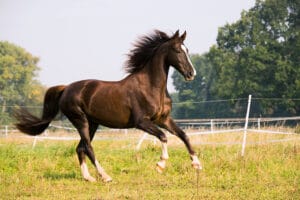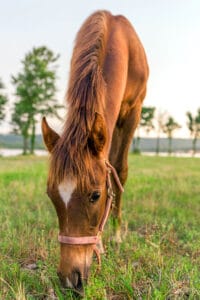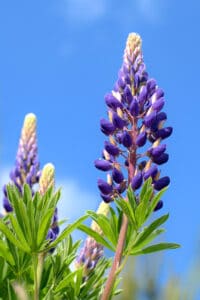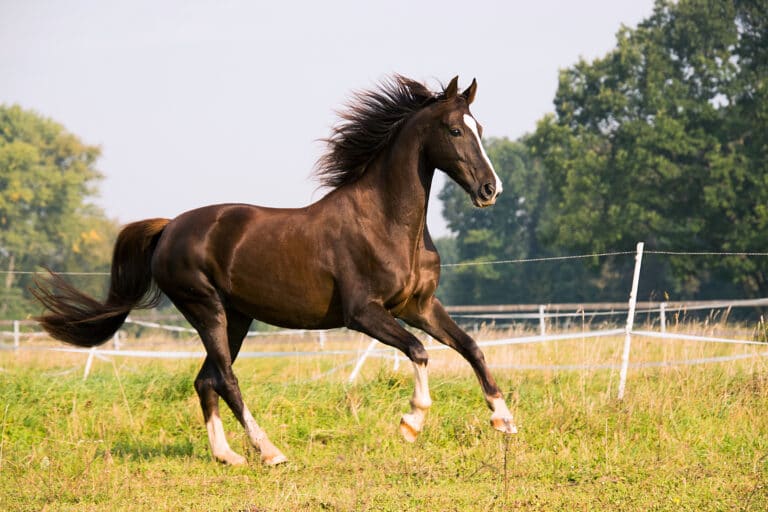Equine nutritionist LARISSA BILSTON explains why nutrition can influence hot or anxious behaviour and what you can do to minimise the problem.
As prey animals, horses are naturally perceptive to potential dangers and will prime themselves for flight instinctively. A horse’s tendency towards hot or anxious behaviour is influenced by breed and genetics, life experience and training, as well as the type and amount of feed ingested. Identifying possible diet-related causes of altered behaviour is a critical first stage in determining the best nutritional strategy for long-term management of a horse’s health and behaviour.
Nutritional factors that can underpin changed behaviour in horses include:
- Overfed, underworked
- High starch or sugar intake
- Gut-related pain
- Mycotoxin ingestion
- Microbiome and the Gut-Brain axis
- Dietary deficiencies and mineral imbalance.

Overfed, underworked
Overfeeding of hard feeds is one of the most common causes of hyperactive behaviour in horses. When horses consume more calories than they use in a day, they will store some excess energy as body fat, and use some of it for ‘play’. The key to avoiding exuberant misbehaviour is to match calories consumed with calories burned.
The amount of hard feed a horse needs varies according to the sugar and starch (calorie) content of the forage and the horse’s requirement for body maintenance, growth and workload. Changes in pasture or hay quality are not always visible, so it is important to regularly monitor your horse’s body condition for signs that they are gaining or losing weight. Then increase or decrease the size of the hard feed in response to changes in workload and body condition score.
High sugar or starch intake
Although many working horses perform well on grain-based hard feeds, some are prone to hot behaviour and become easily excited or nervous on high sugar or high starch diets. The reasons for this are largely unknown but are likely due to spiking blood sugar and elevated pro-inflammatory cytokine levels and/or gut issues related to the microbiome via the gut-brain axis, or pain caused by gastric ulcers or hind gut acidosis.
Gut-related pain
The pain caused by gastric ulcers in both the squamous (upper) and glandular (lower) regions of the stomach can cause poor or changed behaviour. Gastroscopy is required for a correct diagnosis, and the treatment protocol depends on ulcer severity and the affected region of the stomach. Lifestyle and dietary changes are usually necessary for successful management of gastric ulcers.

Horses prone to ulcers need free choice access to forage (unless overweight). Cereal hay, chaff, and cereal grains including barley, wheat, oats, corn, millrun, bran and pollard should be avoided. Also avoid feeds with added molasses or honey – so read bag labels carefully. Choose low GI hard feeds by mixing your own or looking for premixed feeds made from legume grains (e.g. lupins), ‘super fibres’ (like beet pulp, soy, or lupin hulls), oilseed meals, or oil. Feeding lucerne just prior to exercise is also recommended to buffer stomach acid and prevent splash burning the squamous region of the stomach.

Hindgut acidosis occurs when high levels of undigested starch and sugar overflow into the caecum and colon. Microbial fermentation of sugar and starch in the hindgut creates more acidic volatile fatty acids than those produced by fibre fermentation, which can cause ulcers in the gut lining.
Hindgut acidosis can occur suddenly, when horses are turned out onto a fresh paddock of lush, high sugar pasture for example, or after the quick introduction of high starch hard feeds. Chronic hindgut acidosis occurs when horses are fed large meals of high starch ingredients which can’t all be absorbed in the small intestine and are fermented in the hindgut.
Minimise the risk of hind gut acidosis by feeding every six hours with a meal that’s below 500 grams per 100 kg of horse bodyweight, and limit access to high sugar grass (especially lush new shoots in autumn and spring, or following a frost). Research shows that the addition of protected forms of the live yeast Saccharomyces cerevisiae stabilizes hindgut pH and maintains a more diverse microbiome. Buffers such as bicarbonates that are protected until they reach the hindgut are another useful tool when starch and sugar intakes cannot be reduced sufficiently.
Mycotoxin ingestion
Mycotoxins are harmful substances produced by bacteria and fungi growing on forage and grains. They can be present in pastures and grains pre- and post-harvest as well as in hays and silage. After ingestion, mycotoxins can negatively impact gastrointestinal function, disrupting the intestinal mucosa and the microbiome before being absorbed and causing neurological symptoms and organ damage.
The symptoms of mycotoxin load in horses depend on many factors including the type and amount of toxin present and the individual’s immunity or tolerance to mycotoxins. It is not unusual for one horse in a paddock to be much more affected than others. Symptoms of mycotoxin issues affecting the nervous system may include:
- Unpredictable, irritable, or spooky behaviour, out of character for the horse’s temperament
- General crabbiness when ridden, pinning ears, swishing tail, kicking out
- Girthiness, not standing for saddling/mounting
- Tight, tense, impulsive flight response
- Head shyness and sensitivity to touch, noise or sudden movement
- Aggressiveness towards people or horses
- Hormonal behaviour in mares and ‘riggy’ behaviour in geldings
- Separation anxiety
- Head shaking or flicking.
Adding a broad-spectrum mycotoxin binder to the feed can help to address these issues. Options to reduce exposure to mycotoxins can include limiting grazing hours or removing horses from affected pastures during certain times of the year.

Microbiome and the Gut-Brain Axis
Exciting new research is emerging to demonstrate the significant influence of the gut microbial population on animal health and behaviour. Disruption to the balance of gut microbial species (as occurs during emotional or physical stress) has been demonstrated to cause behavioural change in some species.
Animals treated with probiotics have measurably lower levels of corticosterone, a stress hormone. Scientists believe that supplementation with probiotics to improve digestive comfort is a plausible strategy for behaviour modification in horses. Supplementation with live yeast Saccharomyces cerevisiae or certain Lactobacillus bacterial species maintains the natural diversity of hindgut bacterial populations. This keeps hindgut pH more stable, potentially avoiding behaviour modifying deficiencies in the vitamins and amino acids normally provided by a healthy hindgut microbiome.
Dietary deficiencies and mineral imbalance
When a horse’s body lacks essential nutrients, behavioural and neurological symptoms commonly referred to as grass-affected behaviour can occur. For example, grass tetany and staggers can be caused by an imbalance in the macrominerals sodium, magnesium, nitrogen and potassium.
Dr Thomas Swerczek, a veterinary pathologist at the University of Kentucky says that supplement changes may be necessary when horses graze stressed pasture forages, especially grass in the spring and autumn when cold-stress and drought stress occurs. The use of herbicides also dramatically stresses grass pastures. The levels of potassium and nitrate spike in stressed plants, while sodium declines in pasture forages. Excessive potassium and nitrate can be corrected by adequate salt in the diet, both as a preventive and when symptoms are acutely occurring.
Calcium and magnesium levels need to be balanced to maintain normal muscle contraction and relaxation. Ensuring correct dietary balance between calcium, phosphorous and magnesium is critical to optimize uptake and avoid painfully tight muscles after work. There is no scientific evidence to support the use of excessively high levels magnesium or calcium in any form as a ‘calmer’ or to improve brain function or reduce excitability. A high oxalate intake from some C4 pasture species including kikuyu, setaria and buffel grass is a common cause of calcium deficiency. Many diets lack adequate magnesium to achieve an optimal calcium to magnesium ratio, creating a need for magnesium oxide supplementation.
The B group vitamins are important for energy metabolism and nervous system function. Signs of deficiency include decreased appetite and increased irritability. The gut microbial population is responsible for production of much of the vitamin B that horses require, so horses under emotional or physical stress require a vitamin B supplement.
Scientists have found that DHA and EPA, the marine-sourced omega-3 fatty acids, can improve cognitive function in humans. Research from many species demonstrates that DHA is essential for normal brain development before and after birth. New work is linking EPA to mood and behaviour. Perhaps in future we will see research linking marine-sourced omega-3 supplementation to improved horse behaviour and learning.
Larissa Bilston, BAgrSc (Hons 1), is a nutritionist with Farmalogic. You’ll find a full length version of this informative article in our VIP area. Log in to www.equestrianhub.com.au/vip-member/



